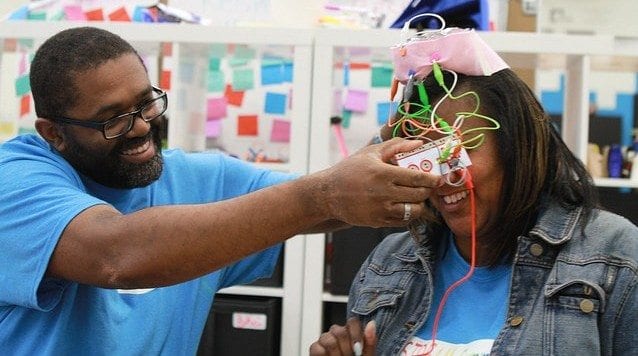 As one of 50 statewide afterschool networks supported by the Charles Stewart Mott Foundation, Maryland Out of School Time Network (MOST) focuses on building good policies and practices to sustain and expand quality afterschool and summer learning programs. Seven years ago, the Noyce Foundation and the Charles Stewart Mott Foundation came together with a shared vision of broadening access to STEM for kids across the country by offering STEM learning in afterschool and summer programs. STEM Next has advanced the Noyce Foundation’s legacy by continuing to support this important effort: 27 afterschool networks, including the MOST Network, have brought STEM learning to 400,000 youth in 5,000 programs across the country so far. The effort has also resulted in a system-building toolkit that shares the lessons learned throughout this initiative.
As one of 50 statewide afterschool networks supported by the Charles Stewart Mott Foundation, Maryland Out of School Time Network (MOST) focuses on building good policies and practices to sustain and expand quality afterschool and summer learning programs. Seven years ago, the Noyce Foundation and the Charles Stewart Mott Foundation came together with a shared vision of broadening access to STEM for kids across the country by offering STEM learning in afterschool and summer programs. STEM Next has advanced the Noyce Foundation’s legacy by continuing to support this important effort: 27 afterschool networks, including the MOST Network, have brought STEM learning to 400,000 youth in 5,000 programs across the country so far. The effort has also resulted in a system-building toolkit that shares the lessons learned throughout this initiative.
One of the initiative’s key lessons is the importance of ensuring that afterschool educators have the skills and confidence to lead high-quality, inquiry-based STEM explorations. Resource-strapped afterschool providers simply cannot deliver this on their own. The MOST Network’s STEMbassador program is a great example of the kind of system building STEM Next invests in: organized and led by the statewide afterschool network, powered by the expertise of local partners, and fueled by the energy of OST educators. Ellie Mitchell, leader of MOST, is our guest blogger this week discussing what STEMbassadors is all about. – Ron Ottinger
Introducing the STEMbassadors!
Guest Author, Ellie Mitchell, Director, MOST
Although the out-of-school time (OST) environment has always been well-suited for STEM exploration, it’s only in the past several years that afterschool and summer programs have been recognized as ideal environments to spark and sustain STEM interest among young people. As expectations for the impact of these learning opportunities on young people increase, so does the need to ensure that OST educators are ready to meet the challenge. Ongoing professional development and supports are needed to help the OST field keep pace. Enter the MOST Network STEMbassadors, generously supported by STEM Next and the H.J. Weinberg Foundation.
Launched in 2013 as part of the MOST Network’s sySTEM, or statewide STEM learning community for OST educators, each cohort of about 20 STEMbassadors comprised of OST educators from community centers, libraries, Boys and Girls Clubs, high schools, and other organizations. The current cohort of 21 STEMbassadors represent seven different counties with programs that serve more than 13,000 youth. A partnership with Harvard University’s Program in Education and Afterschool Resilience (PEAR) enables educators to gather data on the quality of their STEM OST programming and the interests of their participants in STEM. Using the Common Instrument (CI) and Dimensions of Success (DoS) tools, STEMbassadors have discovered that young people arrive at their programs with high levels of interest in STEM and that interest sustains over time. Programs are meeting kids’ needs in the areas of organization, STEM content learning, and positive relationships; but have work to do to facilitate inquiry, ensure kids understand the relevance of STEM activities, and keep kids engaged.
Recently, the current cohort of STEMbassadors attended 40 hours of training in 3D printing, MaKey-MaKey, and the Internet of Things at the Digital Harbor Foundation (DHF). The training included a 3D printer for each STEMbassador to bring back to their program.
Writing for the MOST blog, Muhammad Najee-ullah said, “The lessons and resources provided in the STEMbassador 3-D printing workshop has enabled my team and me to be better familiarized with the 3-D design and print process, and the developing culture around the technology, which has generated some great ideas on how to introduce the technology to our workshop participants in a manner that exercises their creativity and technical literacy, and enhances their enjoyment of the Full Blast S.T.E.A.M. gameplay!”
Said Scott Davis, another STEMbassador, in his blog post, “I brought the 3D printer to our 2nd-grade group at our program one day this week to introduce the concept. The students were super excited. They found it really cool and were amazed by what you can make with it.”
MOST will kick off its fourth STEMbassador cohort this fall. The program will continue its partnership with DHF and focus specifically on helping afterschool professionals support and promote STEM interest in K-12 girls and young women.
For more information see https://mdoutofschooltime.org/initiatives/stem/stembassador_learning_community or reach out to Ellie Mitchell at emitchell@mdoutofschooltime.org


